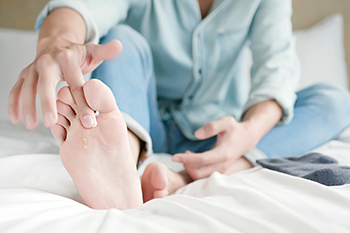
Athlete’s foot is a fungal infection that affects the skin on the feet and between the toes. The fungus thrives in warm, damp environments, making it more likely to develop in people who wear tight, non-breathable shoes for extended periods. Symptoms of an athlete's foot infection include scaly or cracked skin, itching, burning, and in some cases, fluid-filled blisters that can cause pain when walking or standing. The infection spreads through direct contact or by touching contaminated surfaces like locker room floors, socks, or shoes. Without treatment, athlete’s foot can lead to secondary bacterial infections that may cause swelling, warmth, and pus drainage. To manage athlete’s foot, keeping the feet clean and dry is essential. Wearing breathable footwear and changing socks regularly can help reduce moisture buildup. A podiatrist can diagnose the severity of the infection and provide topical or oral antifungal medications. If blisters or open sores develop, additional care may be required to prevent infection. If you have an athlete’s foot infection, it is suggested that you schedule an appointment with a podiatrist for treatment.
Athlete’s foot is an inconvenient condition that can be easily reduced with the proper treatment. If you have any concerns about your feet and ankles, contact Dr. Tupper from Coshocton Foot Health Center. Our doctor will treat your foot and ankle needs.
Athlete’s Foot: The Sole Story
Athlete's foot, also known as tinea pedis, can be an extremely contagious foot infection. It is commonly contracted in public changing areas and bathrooms, dormitory style living quarters, around locker rooms and public swimming pools, or anywhere your feet often come into contact with other people.
Solutions to Combat Athlete’s Foot
- Hydrate your feet by using lotion
- Exfoliate
- Buff off nails
- Use of anti-fungal products
- Examine your feet and visit your doctor if any suspicious blisters or cuts develop
Athlete’s foot can cause many irritating symptoms such as dry and flaking skin, itching, and redness. Some more severe symptoms can include bleeding and cracked skin, intense itching and burning, and even pain when walking. In the worst cases, Athlete’s foot can cause blistering as well. Speak to your podiatrist for a better understanding of the different causes of Athlete’s foot, as well as help in determining which treatment options are best for you.
If you have any questions please feel free to contact our office located in Coshocton, OH . We offer the newest diagnostic and treatment technologies for all your foot and ankle needs.
